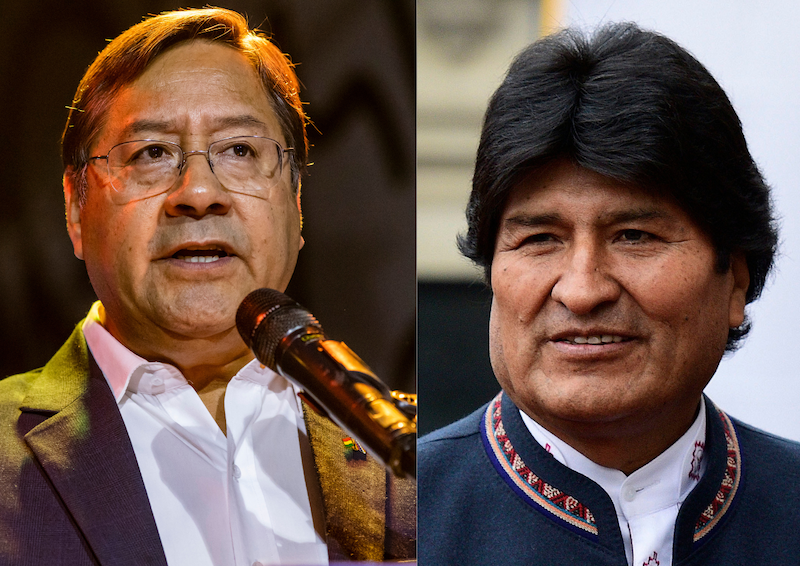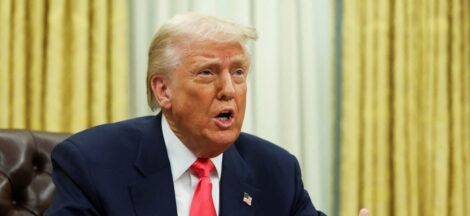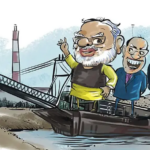By Satyaki Chakraborty
The Latin American nation Bolivia is currently undergoing a major political turmoil as after two years of infighting between the former President Evo Morales and the incumbent President Luis Arce, the ruling left wing coalition was split at a convention of MAS workers on February 25 with the declaration of Morales to form a new party Front for Victory (FPV) dissociating from the President Arce and his followers in MAS.
President Arce who is ruling the country since winning the last presidential elections in 2020 is again contesting the next presidential elections scheduled to be held on August 17 this year. Evo Morales, the founder of MAS conveyed his decision to contest for the Presidential post in 2023 itself with the support of a large number of MAS leaders, but Arce opposed his bid and this along with some other issues led to a bitter fight between the followers of the two leaders in the last two years. Finally Morales formed the new party FPV and he will be contesting the August 17 elections.
Despite economic crisis facing Bolivia, there is no organized opposition. The far right and the right parties are split and they have failed to fight the MAS government in any way in the last four and half years. That way, the MAS support base is strong. Latest opinion polls suggest that even if Arce stands against Morales in the Presidential polls, Morales will be the frontrunner with 40 to 45 per cent votes. This projection has energized the new party FPV and they are going ahead with intensive campaigning in favour of the people centric programme of the former President who during his tenure took a large number of measures for the eradication of poverty and removal of unemployment.
In Bolivia, the indigenous population plays a big role in deciding the fate of Presidential candidates. They are backing Evo Morales in a big way. In fact they took the main role in forming FPV. The bases and leadership are in meetings from 5am to late in the evening. Their latest multi-day march started on January 10 and ended five days later with marchers who suffered bullet wounds and dozens of detentions in La Paz, the centre of government. Since July, peaceful resistance has been met with paramilitary violence, extreme forms of crowd control, and indiscriminate arrests .
The poor believe they are saving their country from a return to neoliberalism, enacted by President Luis Arce. They are organising to protect the largest lithium reserves on Earth for the people, just as the indigenous people saved their natural gas reserves in “the gas war” of 2003 that ousted a president. Bolivian sources say that Arce’s government is trying to force an agreement for lithium extraction that is not helpful to the poor people. The programme is helping the foreign companies more than the Bolivian people.
Though Morales has garnered wide support in favour of his Presidential candidature for August 17 elections, he has still judicial problems. Evo Morales was president from 2006 to 2019 for three term. In December 2023, the Constitutional Court ruled that Bolivia’s constitution prohibits more than two presidential terms, barring Mr. Morales from candidacy – a decision likely to be revisited by the reconstituted court. Seven of the court’s 26 judicial members remain as incumbents, while the remaining 19 judicial positions were newly elected on December 15, 2024. Morales supporters say that the reconstituted Constitutional Court will revise its earlier decision and allow Morales to contest. The final position is expected to be known by April this year.
There are still five and half months left for the Presidential elections on August 17. Presently the President Luis Arce is fighting more his mentor and now rival Evo Morales and his new party FPV to retain his support base, but the weakened opposition may emerge stronger taking into account the division in the MAS support base and the intensification of the current economic crisis.. All the opposition forces, though presently splintered might try to rally around a common leader if the price rise and job crisis intensify further.
According to the economists of the Bolivian government, the root of the financial meltdown lies in a severe balance of payment crisis. Since 2011, Bolivia has maintained a fixed exchange rate of 6.9 bolivianos to the United States dollar, but international reserves have since plummeted to $1.7 billion, one-tenth of their $15 billion peak of 2014. The Arce government is struggling to uphold the peg. Only $166 million in foreign currencies remain – the rest is in gold. Despite legislative changes allowing Bolivia to sell part of its gold reserves, further sales are constrained by a legal minimum reserve limit. This shortage of reserves – primarily driven by the government subsidizing fuel imports − has led the state to hoard dollars and gold, depressing economic activity. The fuel shortages that it triggers are further stoking social unrest.
Already international financial institutions have warned about the gravity of Bolivia’s fiscal challenges. Fitch Ratings downgraded the country’s default rating to CCC from B-, citing dwindling international reserves and the absence of a tangible fiscal consolidation plan. With the foreign exchange reserve nearly depleted and economic risks mounting, a debt crisis has become inevitable. Latin American :Left leaders are worried that there is enough scope for the pro-right opposition to emerge and challenge the MAS whoever is the candidate, taking advantage of divided Left and deepening economic crisis.
Next few months will indicate how the situation shapes up and whether Morales finally gets the Court clearance to contest Presidential polls. (IPA Service)


 Offshore Sand Mining Emerges As Another Centre-States Flashpoint
Offshore Sand Mining Emerges As Another Centre-States Flashpoint 